A journey through the kappa legends of Tono City: A comprehensive guide to Kappa Pool and the surrounding attractions

Kappa also appears in "The Tales of Tono." Experience the kappa legend in Tono City! Visit Kappa Pool, Denshoen Garden, and Jokenji Temple, and try your hand at catching a kappa. We will also introduce popular spots in the area.
-
Table of Contents
- Traditional Garden
- Kappa Tea House
- Jokenji Temple
- Kappa-buchi
- There's only one Kappabuchi pool?!
There is a legend that kappa appear in Tono.
There is also a bounty on the kappa, and if you capture one and go to Tono TV together...you'll get a bounty of 10 million yen!!!
However, in order to capture a kappa, you must obtain something called a "kappa capture permit (220 yen)."
A kappa capture permit can be obtained at the folklore park near Kappa Falls.
Traditional Garden

Denshoen is a facility that recreates the lifestyle of farmers in the Tono region, where visitors can experience traditional events, old tales, and the making and production of folk crafts.

Within the park are the Former Kikuchi Family Residence, a National Important Cultural Property, a memorial hall for Sasaki Kizen, the narrator of "The Tales of Tono," and the Oshira-do Hall of Silkworm Gods, which houses a thousand Oshirasama figures.

There is also a restaurant called Oshiratei where you can enjoy local cuisine.
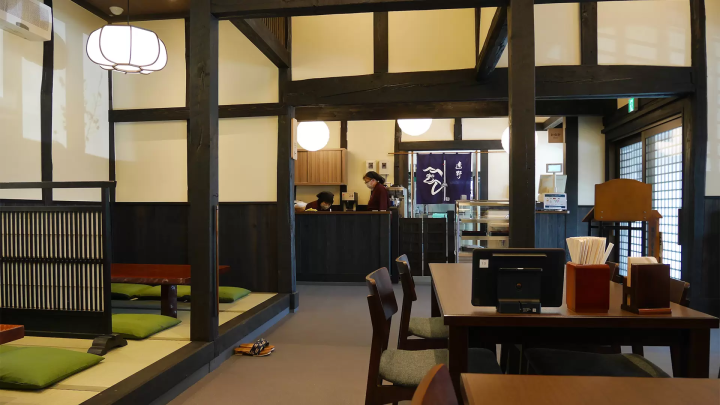
- Access: Approximately 5km from JR Tono Station / Approximately 10 minutes by car
- Opening hours: March to November 9:00 to 17:00 (entrance accepted until 16:30)
December to February: 9:00 to 16:00 (entrance accepted until 15:30)
- Admission fee: Adults 330 yen / Elementary, middle and high school students 220 yen
- Inquiry: 0198-62-8655
- Tono Densyoen X: https://twitter.com/tono_densyoen
*Currently, kappa capture permits can be purchased from the Tono City Tourism Association or through hometown tax donations.
So I bought a Kappa Capture Permit at the gift shop in the traditional gardens.
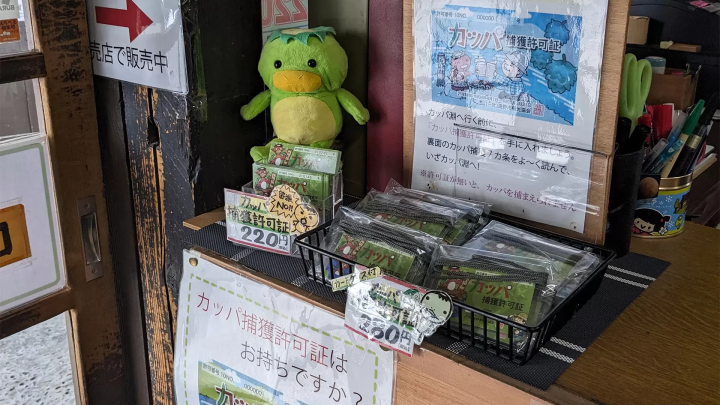
On the back of the permit are the "Seven Rules for Capture," which list things to be careful of when capturing a kappa, such as "catch it without damaging the plate on its head or spilling the water in the plate."
Read the instructions carefully and then go and capture it.
Kunio Yanagita, who was also a folklorist, wrote in his book "Tales of Tono"
"It is not uncommon to see what are said to be kappa footprints in the sand on the riverbank, especially the day after it has rained."
It is spelled as follows.
The most well-known of these is Kappa-fuchi, which flows behind Jokenji Temple. Jokenji Temple's Kappa-fuchi is about a five-minute walk from Denshoen Garden.
Kappa no Chaya
If you walk from Denshoen Garden through the hop fields towards Jokenji Temple, you will come across Kappa no Chaya, a rest stop.
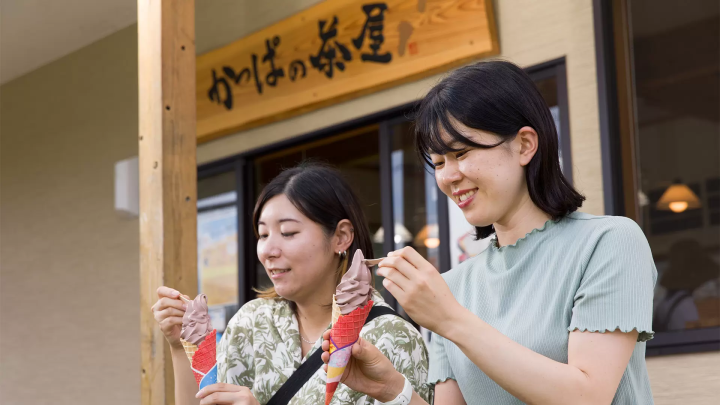
The most popular item at Kappa no Chaya is the Zashiki Warashi Soft Serve Ice Cream, made with plenty of red beans, Zashiki Warashi's favorite food.

The soft serve ice cream has a mild flavor and the red cone design is cute, resembling a kimono.
- Access: Approximately 5.4km from JR Tono Station / Approximately 11 minutes by car
- Business hours: 10:00-16:00
- Closed: Tuesdays and Wednesdays
- Inquiry: 0198-62-3777
- Kappa no Chaya X: https://twitter.com/bo0wjlfcxsg24ez
Once you get here, Kappabuchi is just around the corner.
Jokenji Temple

Jokenji Temple is an ancient and prestigious temple of the Soto sect that was founded in 1490.
Within the shrine grounds is a statue of a guardian dog known as the "Kappa Komainu" (guardian dog) with a circular depression on its head that looks like a kappa's plate when water collects there.

It is said that long ago, when the temple caught fire, the kappa helped put out the fire, and that is why it came to be worshiped here.
Behind this temple is the Kappa Pool. From the side of the main hall, head to the Kappa Pool behind the temple.
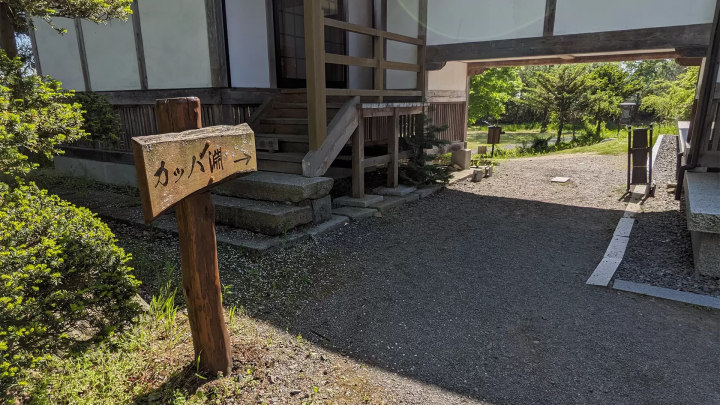
- Access: Approximately 5.3 km from JR Tono Station / 11 minutes by car
- Inquiry: 0198-62-3322
- Visiting hours: 9:00-16:00
Kappa-buchi
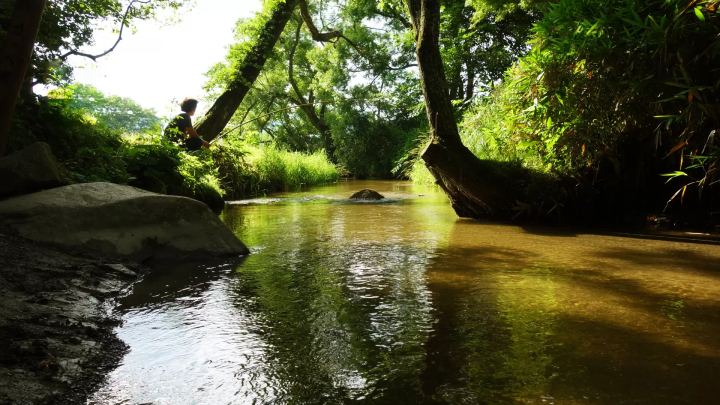
Originally, many kappa lived in the pool of this stream, and there are many stories of them frightening people and playing tricks on them. The gently flowing Kappa Pool is covered in thick vegetation, making it feel like a kappa could appear at any time.
On the banks of Kappa Pool, there are two kappa statues and a shrine dedicated to the goddess of milk, and it is said that if pregnant women make a prayer for breastfeeding, their prayers will come true.

When making a wish, it is customary to make a breast shape out of red cloth and place it in this shrine.
There is a fishing rod at the edge of the pond.

This appears to be intended to capture kappa, but it is not certain whether it will actually catch any.
- Access: Approximately 5.4km from JR Tono Station / 11 minutes by car
In fact, this alone is not all there is to say about the kappa of Tono.
Isn't there only one Kappabuchi pool?
Rivers where kappa have been spotted are called "Kappa Pools," and the most famous pool is the Kappa Pool behind Jyokenji Temple, but this is not the only place where kappa have been spotted. Here are a few places where you can still visit where kappa folklore remains.
Tarobuchi
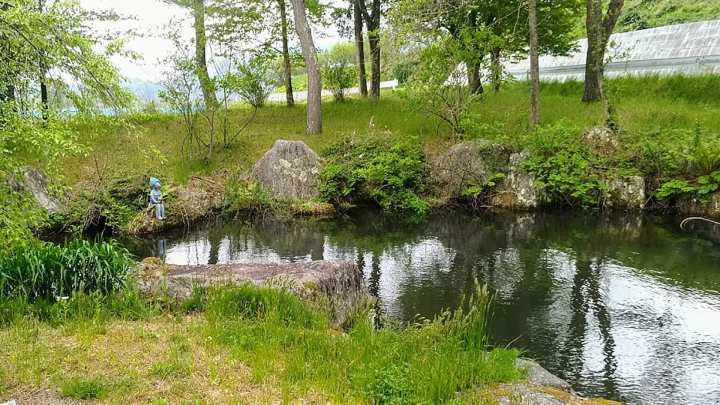
As recorded in the Tales of Tono, "Many kappas live in rivers, especially Sarugaishi River," there are many kappa legends in this river basin. It is said that a kappa named Taro used to live in the pool at Kokoji Temple, and would come to peek at the women of the village who came to do waterworks such as washing, and would always cause trouble by causing trouble. Taro Pool is now a pond, but there used to be another pool below it, where it was said that a female kappa lived who would court Taro Kappa. The pool where the female kappa lived was called Onna-ga-fuchi, and it was said that two kappas lived there.
- Access: Approximately 3km from JR Tono Station / 7 minutes by car
Kappa Pond (Obako Pond)
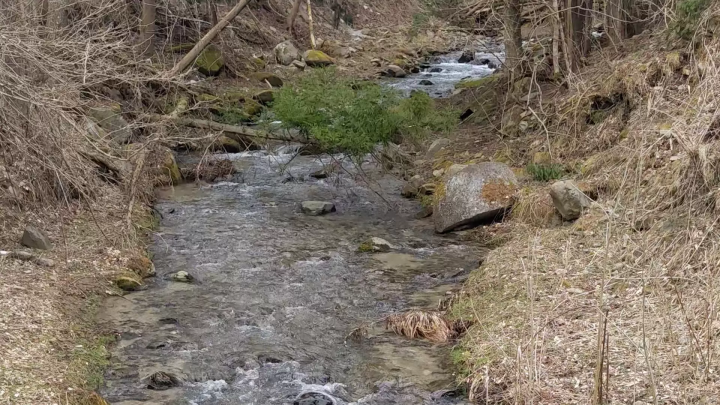
The area known as Yamaguchi Village has had stories of kappa since ancient times. In the 58th story of "The Tales of Tono," a kappa tries to drag the horse of a family called "Shin'ya" into the river, but is unable to resist the strength of the horse and ends up being pulled all the way to the stables.
The villagers gathered together and discussed whether to kill the kappa or forgive it, and in the end they solemnly promised not to cause any more trouble for the kappa and let it go. It is said that the kappa left the village and moved to Aizawa Falls, upstream of the river.
- Access: 9.4km from JR Tono Station / 18 minutes by car
So, will you be able to meet a kappa in Tono?
We are a regional trading company responsible for promoting local products and revitalizing tourism in Tono City, Iwate Prefecture. Tono is home to numerous legends about kappa and zashiki warashi, and is also home to an abundance of agricultural and livestock products that take advantage of its location in a basin, with one of the largest production volumes of hops used in beer in Japan. I'm proud. By interweaving Tono's people, goods, history and culture, we aim to create value unique to the region, refine the Tono brand, and revitalize the region.
The contents on this page may partially contain automatic translation.






























![[2026] Top 5 Strawberry Picking Spots in Tokushima, Naruto| Farms and Access Guide for January to May](https://resources.matcha-jp.com/resize/720x2000/2025/03/06-227165.webp)
![[Yamanashi/ Hokuto City] 4 Hot New Spots Opening in 2026](https://resources.matcha-jp.com/resize/720x2000/2025/12/12-252747.webp)


